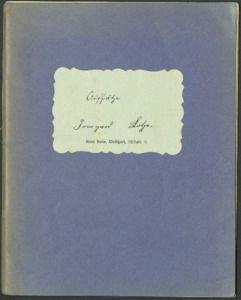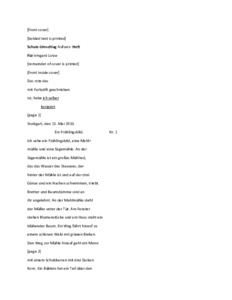
Browse Items (165 total)
Sort by:
-
Transcript of Irmgard Stuhlinger School Essays, 1934-1935
Irmgard Stuhlinger was the wife of Ernst Stuhlinger, a scientist acquired in Operation Paperclip. In these school essays, she discusses her daily life in Stuttgart, Germany, as a child. When writing these essays she was 9-10 years old. Topics of the essays include family life, a fictional moral story, descriptions of the weather, as well as significant historic events such as the Saarabstimmung (1935 Saar status referendum). Furthermore, she mentions Adolf Hitler (German chancellor) and the Sturmabteilung (Paramilitary organization run by Nazi Germany) in these essays. The transcript includes a description of each illustration. -
Irmgard Stuhlinger School Essays, 1934-1935
Irmgard Stuhlinger was the wife of Ernst Stuhlinger, a scientist acquired in Operation Paperclip. In these school essays, she discusses her daily life in Stuttgart, Germany, as a child. When writing these essays she was 9-10 years old. Topics of the essays include family life, a fictional moral story, descriptions of the weather, as well as significant historic events such as the Saarabstimmung (1935 Saar status referendum). Furthermore, she mentions Adolf Hitler (German chancellor) and the Sturmabteilung (Paramilitary organization run by Nazi Germany) in these essays. In this collection, she includes an illustration with each essay. -
Transcript of Irmgard Stuhlinger School Essays, from No. 15
Irmgard Stuhlinger was the wife of Ernst Stuhlinger, a scientist acquired in Operation Paperclip. In these school essays, she discusses her daily life in Stuttgart, Germany, as a child. When writing these essays she was 8-9 years old. Some of the topics include letters to family members, a fictional story, Christmas, descriptions of the weather, and talking about field trips. -
Irmgard Stuhlinger School Essays, from No. 15
Irmgard Stuhlinger was the wife of Ernst Stuhlinger, a scientist acquired in Operation Paperclip. In these school essays, she discusses her daily life in Stuttgart, Germany, as a child. When writing these essays she was 8-9 years old. Some of the topics include letters to family members, a fictional story, Christmas, descriptions of the weather, and talking about field trips. -
Transcript of Irmgard Stuhlinger School Essays, No. 1 to No. 13
Irmgard Stuhlinger was the wife of Ernst Stuhlinger, a scientist acquired in Operation Paperclip. In these school essays, she discusses her daily life in Stuttgart, Germany, as a child. When writing these essays she was 8 years old. Some of the topics include a letter to family members, Christmas, descriptions of the weather, and talking about field trips. -
Irmgard Stuhlinger School Essays, No. 1 to No. 13
Irmgard Stuhlinger was the wife of Ernst Stuhlinger, a scientist acquired in Operation Paperclip. In these school essays, she discusses her daily life in Stuttgart, Germany, as a child. When writing these essays she was 8 years old. Some of the topics include a letter to family members, Christmas, descriptions of the weather, and talking about field trips. -
"Master plan for documentation management and use."
The objective of this study is to describe a comprehensive plan for the development and full utilization of methods and means to be employed in the years prior to 1976 for the effective acquisition, collection, storage, retrieval, distribution, and use of engineering documentation. Because of the violently changing state of the art of data acquisition, storage, and retrieval the description of the plan does not embrace the details of a total decade of phased change. Rather it describes actions that can and should be taken in the relatively near future, and proposes a continuing series of later studies to keep this plan current for the full decade. -
"Corrosion problems associated with the Saturn space vehicles."
Corrosion problems associated with space vehicles, in general, are discussed as contrasted to those problems experienced with structures in an earth atmosphere. Primary emphasis is placed on structural alloys in this discussion, although some corrosion failures experienced in various mechanical components are described. General corrosion prevention measures are indicated, and solutions to specific corrosion failures described. Major failures experienced have been attributed to stress corrosion cracking, rather than general or galvanic type corrosion. Most such failures have occurred with only five different materials: three aluminum alloys - 7075-T6, 7079-T6, and 2024-T6; and two precipitation hardening stainless steels - 17-7PH and AM 355. Corrective actions were different in each case, but involved either a complete change to another material, a change to a different temper of the same alloy, or a modification of the heat treatment and/or general processing techniques. General conclusions are that the types of failures described could be avoided by: a more suitable selection of alloys in the initial design, a realistic review of the environments that could be encountered in the service lifetime of the component, lowering stresses, improving process controls, and effecting better familiarization of design personnel with the with the overall stress corrosion problem in an effort to reduce human error.; Preprint 18e.; Materials for re-entry and spacecraft systems - spacecraft materials.; Materials Conference, Philadelphia, Pennsylvania, March 31 - April 4, 1968. -
"A comparison of four control systems proposed for Saturn V launch vehicles."
Presented are the results of a study comparing four proposed control systems for the first stage flight of Saturn V launch vehicles. The primary basis of comparison is the effect on structural loads, using the bending moments at three stations as load indicators. Two of the systems sense only the vehicle attitude and attitude rate, while the other two systems also sense the lateral acceleration. A yaw plane wind response analysis, including rigid body translation, rigid body rotation, four bending modes, five slosh modes, and a non ideal control system, was performed. The winds used in the study were the Marshall synthetic profile and three selected Jimsphere-measured real wind profiles. Load relief obtained from the addition of accelerometer feedback in the control loop amounted to about 10 percent at maximum bending moment station. In view of predicted structural capabilities of the vehicle, this reduction in loads was not considered sufficient to offset the added complexity and the slight reduction in rigid body stability . -
"The development of the Saturn system safety program."
This paper describes the major highlights or milestones passed in the development of a System Safety Program at MSFC since early 1967. it discusses accomplishments, problems resolved, and decisions made for Apollo Saturn vehicles AS-501 and AS-502, and projects that are to be accomplished on future Saturn vehicles.









